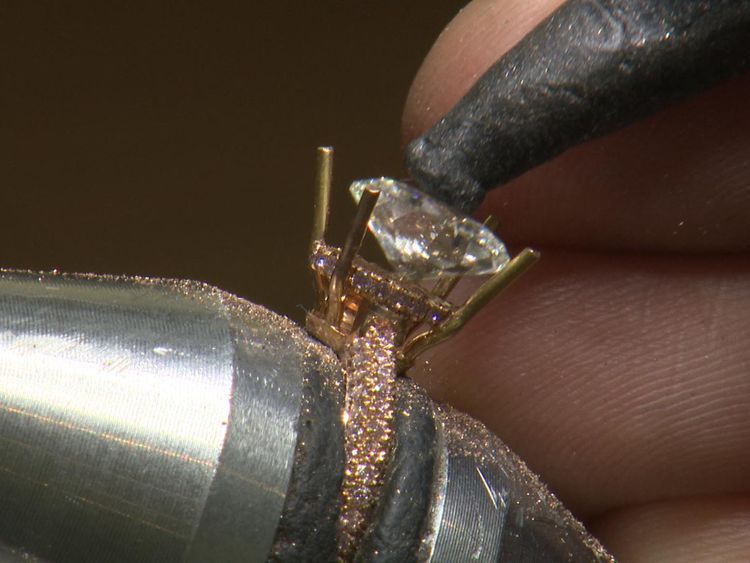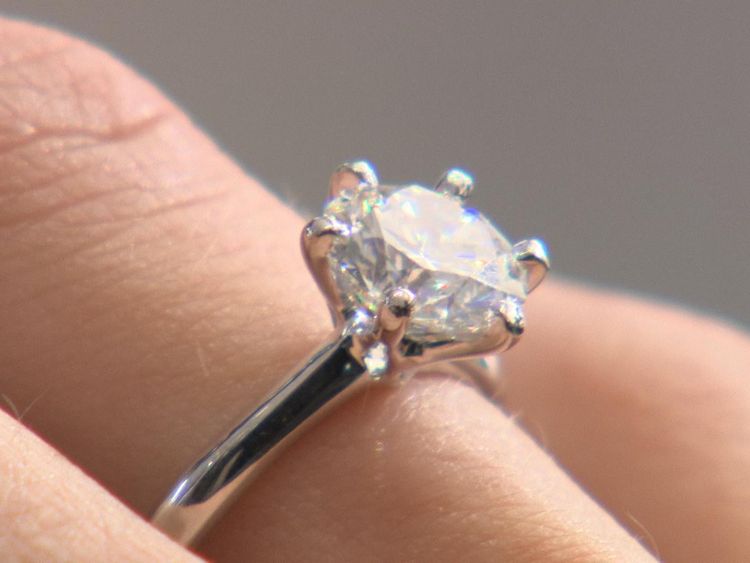Diamonds can now be grown in a laboratory that are so pure they are virtually indistinguishable from natural stones.
Sky News was given rare access to a lab where a one carat diamond can be "cultured" in a matter of days.
And in an astonishing example of modern day alchemy the raw ingredients are just methane and hydrogen gas.
Professor Oliver Williams of Cardiff University makes diamond sheets for research into semi-conductors. But the same process can be used to grow gems.
He said: "The diamonds are purer than anything you would see in nature.
"With the best growers, less than one atom in a trillion is an impurity."
:: World's 'most beautiful' diamond sold at auction for £25.5m
Prof Williams starts the process by putting a small "seed" diamond in a vacuum chamber to exclude air.
He then pumps in methane and hydrogen gas which are heated to 3,000C, which forms a plasma.
The gases break apart, with carbon from the methane being deposited on the seed diamond.
The carbon copies the crystal structure of the diamond, which grows at a rate of around 0.006mm an hour.
Natural diamonds are created over millions of years in the high temperature and pressure 90 miles below the Earth's surface.
But Professor Williams said lab-grown diamonds deserve more attention.
"It's man actually beating nature," he said.
"We're perfecting it. So for me there's an emotional thing to that too – because it's an enormous accomplishment to grow a material that traditionally has been very difficult to grow."
:: 'Masterpiece' Pink Promise diamond sells for £24.1m in Hong Kong

Several companies around the world are now growing diamonds for jewellery, with prices around 15-20% less than a natural stone of the same size.
They can make diamonds yellow by adding nitrogen to the vacuum chamber, or blue by adding boron.
Savvy + Sand is thought to be the only jewellers in London's Hatton Garden to sell both natural and man-made diamonds.
Sandeep Babber, who co-owns the shop, said the two are indistinguishable to the naked eye.
Lab-grown, or "above ground", stones make up less than 10% of his diamond business, but interest is growing.
He said: "I think it's so personal. Of course we have customers that love the idea of above ground diamonds, that it has less environmental impact (than mining).
"But then the majority of our cliental still do opt for the natural diamond. I do feel it's purely marketing driven.
"Above ground stones have not had time to be marketed as extensively."
Until the 1940s diamonds were not the norm for engagement rings. But then De Beers began its "A diamond is forever" marketing campaign and demand boomed.
The industry was challenged by the film Blood Diamond which focused attention on mining profits being used to fund conflicts in Africa.

After starring in the film, Leonardo DiCaprio invested in a lab-grown diamond company "cultivating real diamonds in America without the human and environmental toll of mining".
But companies say increased transparency now allows diamonds to be traced, guaranteeing that they come from ethical sources.
Nevertheless the rise of lab-grown diamonds is causing a stir in the mining industry. It takes a £10,000 machine to tell the stones apart.
But Jean-Marc Lieberherr, chief executive of the Diamond Producers Association, said the value of a gem is partly due to its sentimental quality.
He told Sky News: "The fact they cannot be distinguished with naked eye does not make them identical, or equal.
"Think of very good replica of Picasso painting. We might not be able to tell it apart, but with the right equipment an expert will be able to.
"One has enormous monetary and emotional value, one is a replica with no inherent or resale value.
"It's the same thing with diamonds. Effective industrial replicas of the real thing."
But Professor Williams does not see the difference.
More from World
"Carbon atoms are the age of the universe, or at least the last time it came out of a star," he said.
"To me it's just carbon! But I am a scientist so perhaps I have a different approach to things."
[contf] [contfnew] 
Sky News
[contfnewc] [contfnewc]






